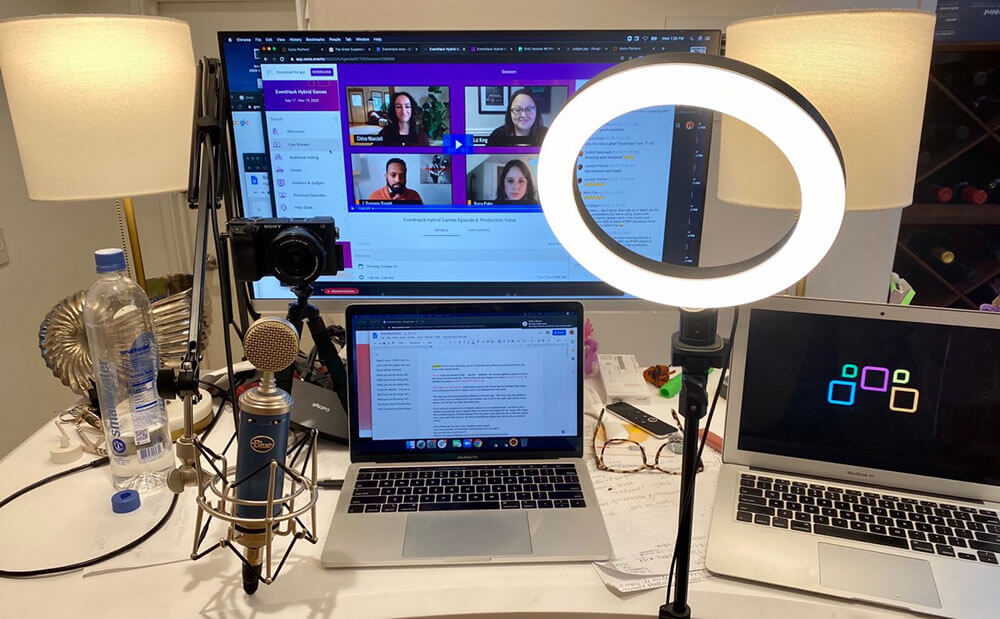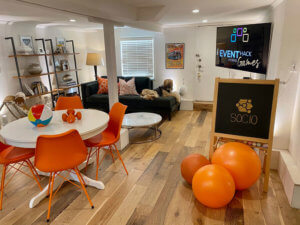
Rings lights are helpful for a self broadcast, but desk lamps arranged on a stack of books near your computer can work wonders, too.
When in-person events were first moved online, audiences were more tolerant of a less-than-professional production. But after months and months of digital events, we’ve come to expect more polish and a crisp narrative — something akin to a television broadcast.
To help us look through the eyes of broadcast professional, we turned to Terisa Whitted, a Bay Area–based television producer who has worked on reality television shows on the HGTV channel and a California-grown version of “Shark Tank.” Whitted also has acted as a consultant on the production of Socio’s EventHack Hybrid Games, which brought event professionals together over 10 weeks to hack the hybrid experience.
That’s where Whitted learned that online event producers face challenges even more complicated than what television producers encounter. In creating online events, she said, producers can find themselves stringing multiple technology solutions together, compared to the television industry where the basic production methods are standardized and distribution channels already are established.
Here is what Whitted had to say when we asked for her top tips:
Know your audience and your production goals. “In TV, it’s called demographics. Is your audience mostly new grads or senior executives? Scientists or tech engineers? Everything they see or hear on your ‘show’ — from the backgrounds you choose for speakers, to music, wardrobe, and props — should resonate with your target audience.”
Casting matters. “If you think of a digital event like a TV show, it’s easy to see that it’s the personality and energy of the ‘host’ or main character who keeps the audience engaged. So, look carefully and critically at who you choose as the ‘faces’ of your digital event. Could you imagine them on TV? Many CEOs and senior executives might seem like obvious choices for speakers, but often they are not the telegenic, sparkly, humorous people who are great on camera.
Your event will fall flat with monotone talking heads, regardless of their title. The impact of using someone who is ‘great on camera’ can’t be overstated. Find the great ones and use them.”
Production quality is easier than it looks. “With everyone stuck at home, even Hollywood is going DIY. Do you need a ring light? Maybe. But desk lamps arranged on a stack of books near your computer can work wonders — the more soft lighting in the room, the better. So play around — if you are broadcasting from your home, log onto Zoom and carry your laptop around and really study how each area of your house appears on your screen. Never sit with a window at your back — the light will blur you out. But natural light from a window filtering in from the side usually works nicely. Try the lighting out by Zooming a friend before you go live.”
Think in sound bites. “The average person is now suffering from Zoom and digital event fatigue. How do you stand out? By keeping your content fun, focused, and moving: Boom. There’s a reason why Twitter works so well — it forces you to get to the point. In TV, the audience sticks around as long as the action is lively and the plot moves quickly.
Some audiences may be tuning in for deep dives and looking for hours of content. But for the most part, challenge yourself to make your content as tight as possible. One reason TV and entertainment works so well is that they make people feel as if they have taken a break from reality. Take the opportunity to both educate and entertain — people will love you for it.

Terisa Whitted helped Socio’s CMO Corey McCarthy tweak her living space to create a backdrop for the EventHack Hybrid Games.
Always create a run of show. “Your run of show is your playbook. Just like a TV producer, you will need to account for literally every second of airtime. Even non-scripted reality shows plan each segment down to how much time every scene will take, and these shows have the advantage of editing, if the wheels come off the bus. Live events do not.
You may not be able to plan exactly what people will say during every moment of your event, but you can plan the exact amount of time they have to say it in. Plan down to the minute and stick to your plan — reverse engineer how much time each speaker will have, how much time is allotted for intros, additional videos, and Q&As, etc. Be sure everyone involved understands the plan and can do a tech check and practice run-through before the event.”
Audio matters. “Most computer mics are fine but investing in a professional mic is ideal if you plan to host many events. You never want the audio to be hard to hear. Beware of multiple audio streams in the same room as they can cause unintended loud distortion noises. You do need to be sure you use a quiet location. Have a plan B. And test and retest your audio tech — remember, no audio, no event. Also: poor audio, poor event.”
Know your technology. “Practice and rehearse like your life depends on it. Not all tech is created equal. Depending on the size of event you’re planning and the number of faces you hope to see on your screen for your event, you may need to hire a tech company. Ask around. Who produced the digital event you liked the most?”
Be professional, be prepared, but keep it real. “Kids photo-bombing your event? Dogs parading in and out? I was on a set once on location in San Francisco when a pack of angry dogs came out of nowhere in the middle of a take and tried to attack the celebrity host. Security and crew leaped into quick action, averting serious injury. But the show had to continue, or a lot of money would have been lost on a wasted day of filming. Lesson learned? Never freak out. Hold your composure and ask yourself, What would the Queen of England do? Smile and wave. And keep gracefully moving forward.”
The bottom line: You know your audience and their expectations best. A well-organized, expertly timed event, with well thought-out content that seems to flow effortlessly is the new quality. The goal is to always to leave them wanting more and eager to tune in again next week (or however often your event occurs) and motivated to share their experience on all their media channels. .
Barbara Palmer is deputy editor of Convene.
